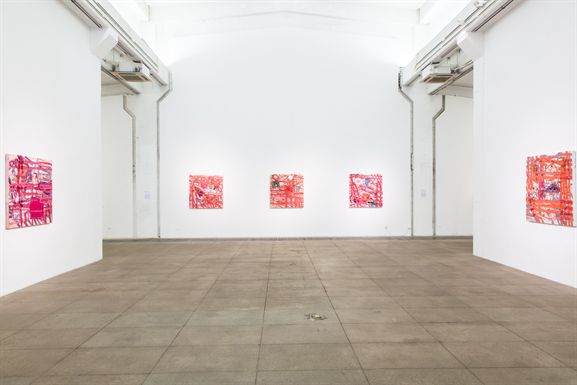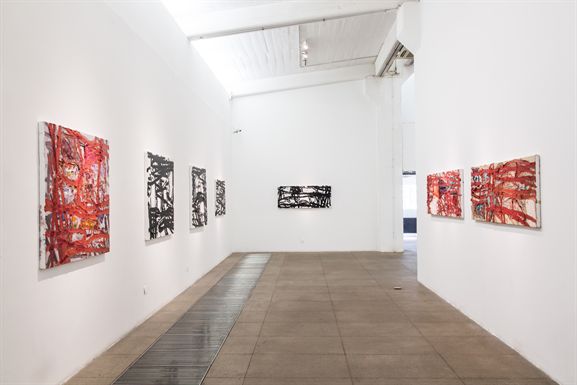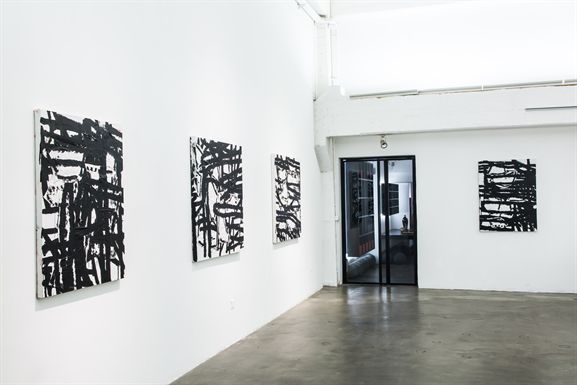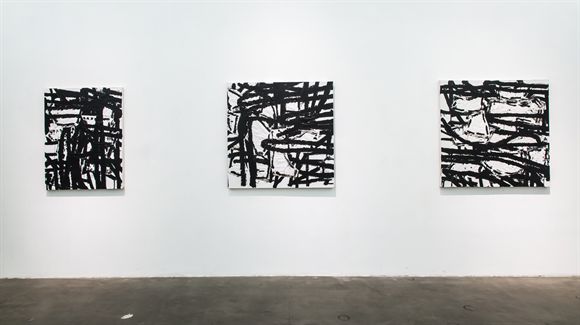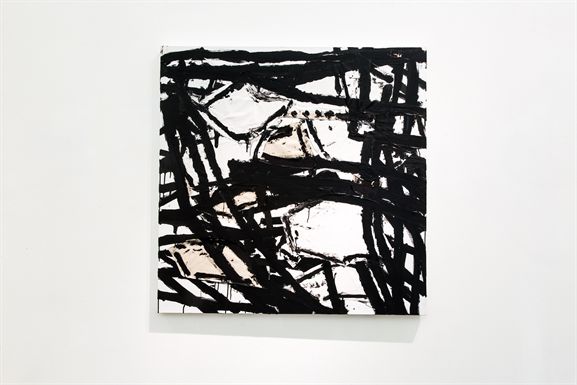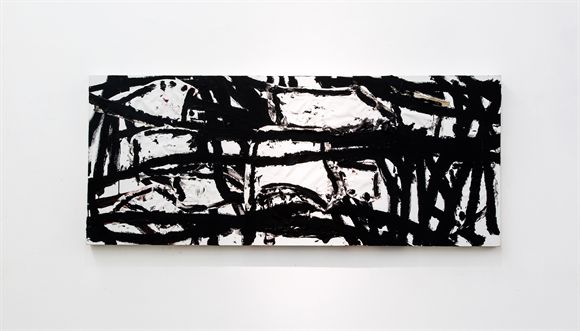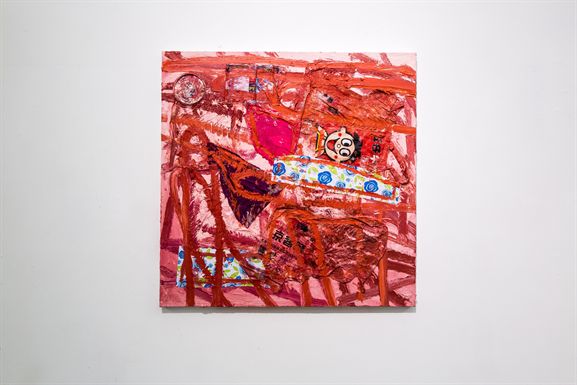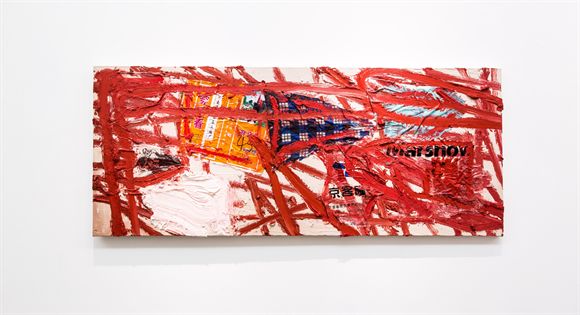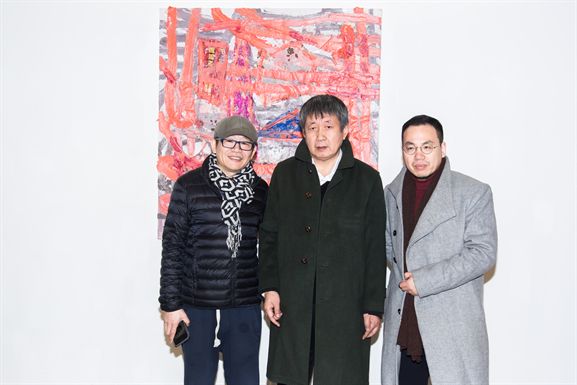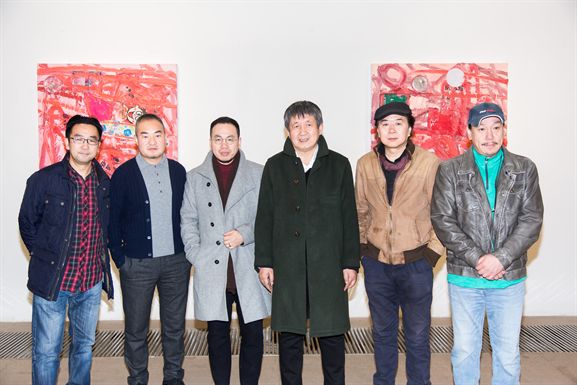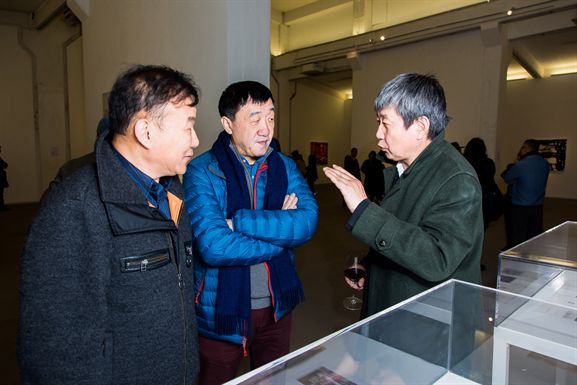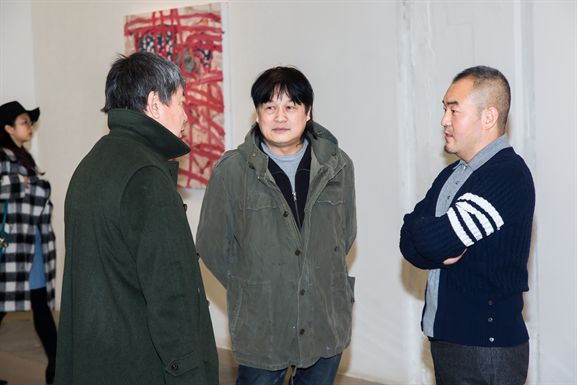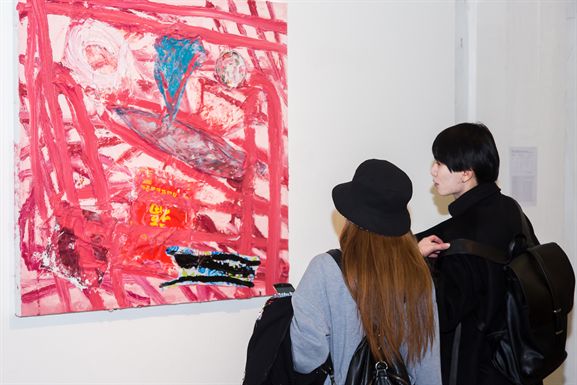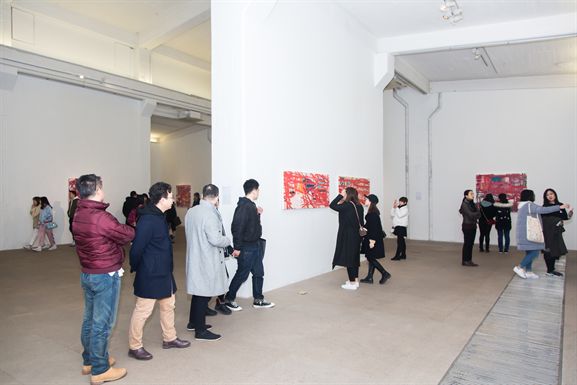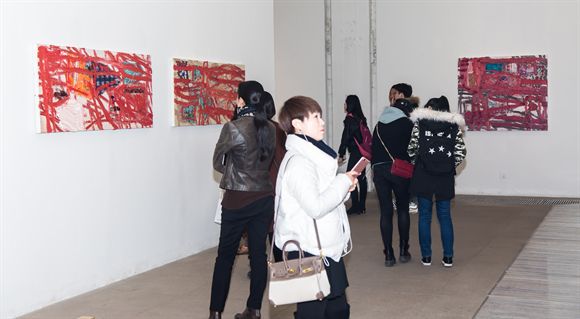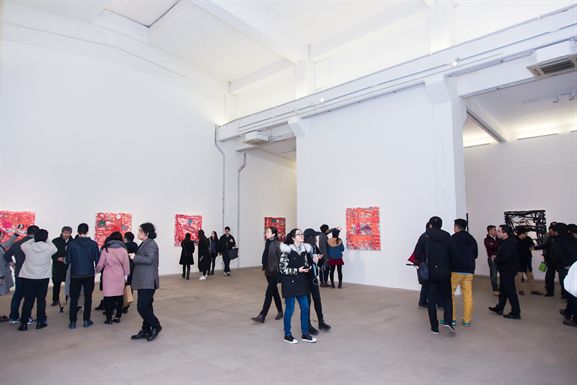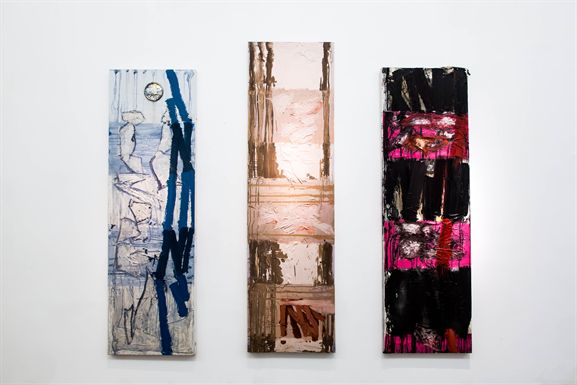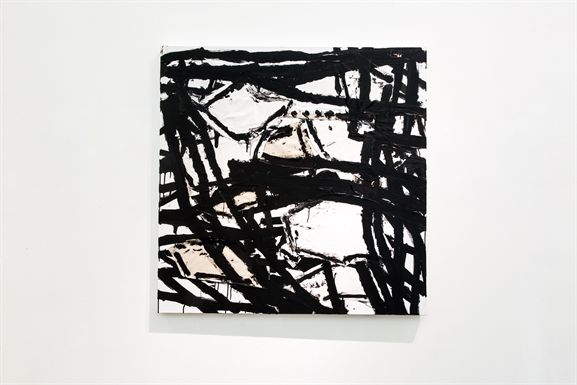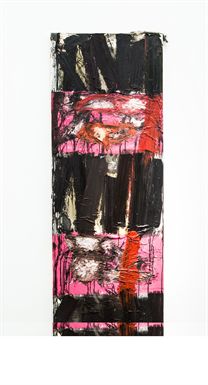Mar 10 - Apr 20, 2018
Press Release
The Whitebox Art Center is delighted to announce the opening of “The Wound is Healing – Li Xiangyang’s Posturalist Painting Exhibition” curated by renowned art critic Wang Duanting, on March 10, 2018. It marks Li Xiangyang’s first large scale solo exhibition in China, presenting more than twenty works of soft-edge and material abstraction completed between 2014 to 2017.
In 1981, as a senior student at the fine art department of the Beijing Film Academy, Li Xiangyang received the National Arts Funding to study in Italy. He was enrolled at the Center for Experimental Film in Rome and the Fine Art Academy of Rome respectively. Being part of the Western cultural environment and under the guidance of Toti Scialoja, Li Xiangyang had proficient command on the essential components of abstraction since his first exposure to the genre and had integrated them into his own practice of abstract paintings. He returned to Beijing in 2005, with more than two decades of learning and practical experiences from Italy and the re-acquaintance with the local social and cultural environment, Li Xiangyang opened a new chapter for his abstract painting. The transformations are not only apparent in the works of art, but also in the spirituality they embody.
Bill Viola states, “Even when we use the terminology ‘artistic language’, but the art is in the things invisible to the eyes.” This statement is especially accurate to describe abstraction, because it's an artistic genre that reveals the truth about the world and life. Since his return to China, Li Xiangyang’s abstract paintings presented transcendental sensibilities and restlessness. His artistic style transcends the formalism in Abstract Expressionism, and his works convey the artist’s calm or anxious states of being. Curator Wang Duanting defines this type of abstraction that conveys the artist’s states of beings by means of material medium through visual perception as “Posturalism”.
This exhibition brings together Li Xiangyang’s most recent Black and Red series of abstract paintings.Not only the two series reveal strong tonal contrast, but the immense disparities between different cultural interests. Westerners show pride from displaying unprecedented energy, where the orientalists have a particular appreciation for the aesthetics of quietude. Rather than considering Li Xiangyang has fully integrated the opposing artistic essences from the East and West together, it’s better to conceive his works of art as the embodiments of thereconciliations between these contending artistic interests. For Li Xiangyang, the two decades of life experiences in Italy have left him profound impacts, and his abstraction represents the spiritual wound left from the clashes between Chinese and Western cultures, and now, the wound is healing. The exhibition will continue to April 20.
Curator Article
In 1981, as a senior student at the fine art department of the Beijing Film Academy, Li Xiangyang received the scholarship of Chinese government to study in Italy. He was enrolled at the Center for Experimental Film in Rome and the Fine Accademia di belle arti di Roma, and studied under the acclaimed art director Ugo Ferranti, and the director of the Fine Accademia di belle arti di Roma, Toti Scialoja, and has not returned to Beijing until 2005, his studies and life in Italy spanned 24 years. This long period of studying and living in Apennine shaped his artistic style, and influenced his way of life. In Fact, Li Xiangyang’s art is the record and essence of his life.
Started with Soviet realism, then transitioned with impressionism and expressionism, and eventually found abstraction, Li Xiangyang’s artistic path followed a logical process, and in certain ways has certain universality. In comparison to the experiences of many Western abstract artists, where one’s artistic passage would head towards the gate of channeling emotions. In fact, when Li Xiangyang first saw a painting by Willem De Kooning’s abstract expressionist painting in the Guggenheim collection in 1985 in Venice, he was immediately surrendered by its passion and energy. It was in the same year, Li abandoned figurative painting that modeled on nature, and resolutely chose the path of abstract painting. Among artists in Mainland China, Li Xiangyang is considered one of the earliest to adopt abstraction as his artistic genre. Even though he’s returned to the world of figuration at certain points in his artistic career, while he continued to explore and penetrate in the domain of abstraction.
Being part of the Western cultural environment and the guidance of Scialoja, Li Xiangyang had proficient command on the essential components of abstraction since his first exposure to the genre. He had a natural ease with the color, brushwork, material and surface in the practice of abstract painting, and had integrated them into his own of works. In other words, not only was he certain about what to express, but also how to do it. His first series of abstract paintings appropriated the styles of De Kooning, Pollock, Rothko, Guston and Scialoja, and through vibrant colors, fluid brush works and passionate enthusiasm, he amalgamated these styles together. In 1986, Scialoja spotted one of Li Xiangyang’s large-scale abstract painting, and applauded him with excitement, “Hereon, I don’t have anything else to teach you!” In 1987, once Li held his first solo exhibition at the Galleria Ferro di Cavallo in Rome, he decidedly to abandon this painting style that primarily embodied abstract expressionism, instead he turned towards adopting ready-made and collage in the practices of Pop artist Robert Rauschenberg and Neo-Expressionist Julien Schnabel. It’s the approach of adding plastic, newspaper, the lid of the paint can and other materials onto the painted canvas with abstract forms, the introduction of these non-painting materials stimulated fundamental changes to the nature of abstraction, so the viewers would have dissociative reactions from a visual and psychological perspective, whereby considerably weakens the abstraction as a mean of emotional release. In fact, this fosters a conceptualized abstraction, a strategy in the “post-abstraction” transition since minimalism. Although Li Xiangyang’s contentious undertaking was not endorsed by Scialoja, but were highly received by the art world in Rome. In February 1989, the acclaimed Italian art critic, FabrizioD’amic wrote the commentary “Excessivo li Xiangyang” on the Republica where he gave enthusiastic accolades to Li Xiangyang’s works. At the same time, the female Italian critic Ester Coen has created a new notion for Li Xiangyang’s practice, and called it Material abstractionism. In the same year, Galleria Durante held his solo exhibition, and the exhibition poster was published on the Italian international art journal, Flash Art. Since 1987, this gallery began to represent Li Xiangyang’s work, and have collected more than 100 of his abstract paintings.
He returned to Beijing in 2005, with more than two decades of learning and practical experiences from Italy and the re-acquaintance with the local social and cultural environment, Li Xiangyang opened a new chapter for his abstract painting. The transformations are not only apparent in the works of art, but also in the spirituality they embody. Having given up on using mixed materials and collage, Li Xiangyang returned to abstract painting styles; only that he’s reduced using vibrant colors and scape of his color spectrum, instead to focus on the monochromatic color range; the previous unhinged brushworks and whirlpool forms were no longer found onhis canvas, but replaced with horizontal and conical compositions. Unlike Mondrian’s regimented geometric abstraction, or Stella’s hard-edge abstraction form which the artist has left the knife cuts, Li Xiangyang’s painting style from this period can be referred to as “Soft-edge” abstraction.
Once having completed a series of abstract paintings, in 2013, Li Xiangyang again turned to “Material Abstractionism”. Accurately speaking, his style of this period should be call, “Soft-edge and material abstraction, because it has integrated his early period material abstraction and the recent soft-edge. In addition, he’s chosen to engage ready-made materials, primarily various types of plastic, food packaging and plastic shopping bags. Although these materials are pasted on canvas as the base of the painting, and were covered with paint, while the details left exposed are visually striking. In addition, Li Xiangyang no longer adopted the compositional device of color blocks, but overlapping lines in both vertical and horizon directions, and layered them onto his canvas, which provided a sense of spatial depth to his images. On the outer layer, or the frontal color space, Li Xiangyang often used single color lines to cover his image, and in most cases, these lines are mostly red and black. In certain cases, he would also use green. Compare to the works in an earlier phase of art practice, these abstract paintings seemed unsophisticated, raw and energetic, embodying greater internal tension and visual impact, which often left its viewers strong impressions. In fact, since the inception of his artistic practice to the present, Li Xiangyang has consistently kept the use of wide lines, unhinged calligraphic and vibrant color textures stylisticallythroughout the entirety of hisabstract painting practice. In addition, the notion of “gestural abstraction” also corresponds to the flat “color-field paintings”. Motion and stillness are two disparate styles, and together they create distinct contrast within the same imagery. Li Xiangyang’s abstract paintings have always left his viewers with the quick and decisive and satisfying impression.
Nevertheless, once Li Xiangyang returned to China, his abstract paintings did not only showed distinct personal features, but also presented transcendental sensibilities and restlessness. In my view, it’s a painting style that formally transcends abstract expressionism, and his works convey the artist’s calm or anxious states of being. In fact, in the domain of Chinese abstraction, not only Li Xiangyang, but many outstanding artists’s works share this characteristic. I define this type of abstraction that conveys the artist’s states of beings by means of material medium through visual perception as “Posturalism”. Unlike “Formalism”, “Posturalist” abstract paintings reconsider the colorful composition and expressivity, at the same time, emphasize on physical features of the color and its independent value. More importantly, “posturalist” abstract artists are interested in the isomorphic qualities between inner spirituality and outer impression of the painting, these types of paintings are replete of the artists’ life.
Bill Viola states, “Even when we use the terminology ‘artistic language’, but the art is in the things invisible to the eyes.” This statement is especially accurate to describe abstraction, because it's an artistic genre that reveals the truth about the world and life. On the surface, Li Xiangyang does not stick to trifles, and somewhat careless, but in fact, he’s a sensible and reflexive artist. Not long ago, he stood in front of a painting at his studio and said, “The wound is healing!” With which I have captured the secret of his abstract paintings. How could Li Xiangyang been wounded? Where was he wounded? And what kind of wound was it? Through our conversation, I suddenly understand the unspeakable meaning concealed in his abstraction.
Hu Shi once said,“To study overseas is a national shame”, it’s difficult for those who have not had the same experience to conceive their feelings and senses. China’s inferior cultural position has been one of the reasons for many students to study overseas, and for this very reason every Chinese oversea student are often discriminated by local society or individuals. This kind of humiliation caused by differences in cultural hierarchy may not be changed with an individual’s effort. Modern history tells us, to study overseas may be a national shame, not going would bring out greater national humiliation, or even disasters. Our journeys to study overseas foster better integrity to our own culture for the future generations in a global context. As for the differences and conflicts between society, politics and culture between China and the West, Chinese oversea students are a community of people with the best understanding. For Li Xiangyang, his life experiences in Italy are profound. He claims this sense as “mentally dissociative”, and his abstraction conveys the conflicts and mental dissociation between East and West. If that’s the case, perhaps Li Xiangyang’s abstract paintings may be interpreted by the French post-modern philosophyer, Gilles Deleuze’s “schizoanalysis”.
This exhibition brings together Li Xiangyang’s most recent Black and Red series of abstract paintings. Not only the two series reveal strong tonal contrast, but the immense disparities between different cultural interests. The black rendered with ink and acrylic demonstrate profound calligraphic tradition, where the lines on the image dance with restrained calmness; where as the ruby, red and rose painted abstract series convey the audacious energy in Western modern painting. Westerners show pride from displaying unprecedented energy, where the orientalists have a particular appreciation for the aesthetics of quietude. Rather than considering Li Xiangyang has fully integrated the opposing artistic essences from the East and West together, it’s better to conceive his works of art as the embodiments of the reconciliations between these contending artistic interests. In fact, Li Xiangyang’s abstract paintings on the one hand convey his spiritual wound, on the other reveals faithful bliss.
Scialoja once claimed, “Li Xiangyang can be cursed, but he’s determined.” This professor’s perception is accurate, he discovered Li Xiangyang’s talent, and influenced his art practice, as well as fore saw his future. It was from the point of inception that Scialoja pointed out Li Xiangyang embarked on his artistic path, and determines to continue to the end.
February, 25, 2018
Wang Duanting, Professor at Institute of Fine Arts, Chinese National Academy of Arts
Installation View
Artworks
- Narrative 3 oil on canvas Comprehensive Material 120×120cm 2017
Media Report

